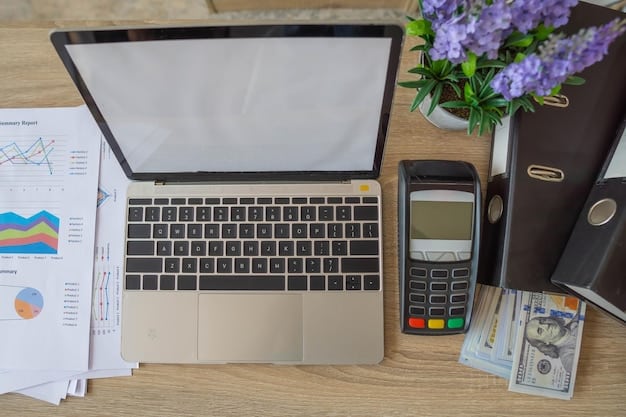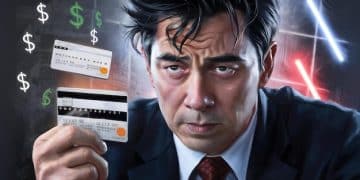Building an Emergency Fund: How Much Do You Really Need?

Building a robust emergency fund is crucial for financial stability, typically recommending three to six months of living expenses, though individual circumstances like job security and health may necessitate more or less to ensure personal financial resilience.
In an unpredictable world, the question, “Building an Emergency Fund: How Much Do You Really Need?” is not merely academic, but a cornerstone of prudent personal finance. It’s about creating a safety net that provides peace of mind, allowing you to weather unexpected storms without derailing your long-term financial goals.
Understanding the “Why”: The Imperative Behind an Emergency Fund
The concept of an emergency fund isn’t new, but its fundamental importance in a rapidly changing economic landscape cannot be overstated. It serves as your primary defense against life’s inevitable curveballs – from sudden job loss to unexpected medical bills or unforeseen home repairs. Without this financial cushion, a minor setback can quickly escalate into a major crisis, potentially forcing you into high-interest debt or liquidating crucial investments.
Think of it as your financial insurance policy, protecting your present stability and future aspirations. It ensures that when life happens, you’re prepared, not panicked. This proactive approach to financial management is what distinguishes resilient individuals from those who consistently struggle to regain their footing after a financial shock. The goal is to avoid situations where you are scrambling for funds, which often leads to costly decisions and increased stress.
Common unexpected expenses that necessitate an emergency fund:
- Medical emergencies or uninsured health events.
- Job loss or significant reduction in income.
- Major home repairs (e.g., roof damage, plumbing issues).
- Car repairs or unexpected transportation costs.
- Unforeseen travel for family emergencies.
An emergency fund liberates you from dependence on credit cards or loans during trying times, thereby preventing the accumulation of high-cost debt. This freedom is invaluable, allowing you to focus on resolving the underlying issue rather than worrying about mounting interest charges. Furthermore, it safeguards your long-term investments, such as retirement savings, from being prematurely liquidated. Dipping into these funds often incurs penalties and misses out on potential growth, severely impeding your financial future. Thus, the emergency fund acts as a critical buffer, preserving your financial integrity across the board.
The Golden Rule: Three to Six Months of Living Expenses
For decades, financial planners have advocated for a general guideline: storing three to six months’ worth of essential living expenses in an easily accessible, liquid account. This benchmark provides a solid foundation for most individuals and households, offering a reasonable buffer against common financial disruptions. But what exactly constitutes “essential living expenses”? It’s not about replicating your entire lifestyle, but rather covering the absolute necessities required to maintain your household.
Essential expenses typically include housing (rent or mortgage), utilities, groceries, transportation, insurance premiums, and minimum debt payments. Discretionary spending, such as dining out, entertainment, or luxury purchases, should generally be excluded from this calculation. The goal is to determine the bare minimum amount needed to keep a roof over your head, food on your table, and the lights on, even if your income stream is temporarily interrupted. This focused approach ensures that your emergency fund directly addresses your most critical needs during a crisis, prioritizing survival over comfort.

The lower end of this range, three months, might suffice for individuals with stable jobs, dual-income households, or minimal fixed expenses. The upper end, six months, is often recommended for those with less secure employment, single-income households, or dependents. It’s a spectrum, not a rigid rule, and your personal circumstances should guide your position on it. The key is to assess your own risk factors and adjust accordingly.
Factors influencing your ideal emergency fund size:
- Job security: How stable is your employment? Industries prone to layoffs may require a larger cushion.
- Health status: Do you have chronic conditions or family members with high medical needs?
- Family situation: Are you a single earner with dependents, or do you have a dual-income household?
- Fixed expenses: Do you have high fixed costs (e.g., large mortgage, car payments)?
- Insurance coverage: How comprehensive are your health, disability, and unemployment insurance policies?
Ultimately, the “golden rule” serves as an excellent starting point, but it requires personalized adjustment to truly fit your unique financial landscape. It’s a living target that may need to be revisited and modified as your life circumstances evolve, ensuring it always provides adequate protection.
Beyond the Basics: When to Adjust Your Emergency Fund Target
While the three-to-six-month guideline is a robust starting point, a truly effective emergency fund strategy acknowledges that one size does not fit all. Various life stages, career paths, and personal responsibilities necessitate a more nuanced approach. Understanding these unique factors allows you to tailor your emergency fund to provide optimal security for your specific situation. This customization moves beyond generic advice to create a financial safety net that is truly reflective of your individual risk profile and needs, ensuring maximum effectiveness when it matters most.
For instance, individuals in highly volatile industries, such as commission-based sales, freelancing, or contract work, often benefit from a larger emergency fund, perhaps nine to twelve months or even more. Their income streams can be unpredictable, making a deeper reserve essential to bridge potential gaps between projects or sales cycles. Similarly, entrepreneurs starting a new business face inherent risks and may need a substantial fund to cover personal expenses while their venture gets off the ground.
Conversely, those with exceptionally stable employment, like tenured government employees or individuals approaching retirement with diverse income sources, might feel comfortable with a slightly smaller fund, perhaps closer to three months. The critical element is a realistic assessment of your income stability and the potential duration of an income disruption. Do not underestimate the time it might take to find comparable employment or recover from a significant event.
Specific scenarios demanding a larger emergency fund:
- Self-employment or freelance work: Income can fluctuate wildly.
- High credit card debt: Having an emergency fund prevents adding to high-interest debt.
- Dependents: More people rely on your income.
- Single-income household: No secondary income to fall back on.
- Pre-existing health conditions: Higher likelihood of unexpected medical costs.
- Large upcoming expenses: Planning for a baby, home renovation, or sabbatical.
The goal isn’t just to accumulate funds, but to build confidence. When considering your ideal emergency fund size, think about how much money you would need to feel truly secure in the face of uncertainty. This “peace of mind” metric can often be as important as the raw numbers, guiding you towards a target that offers psychological as well as financial comfort.
Where to Keep Your Emergency Fund: Accessibility and Safety
Once you’ve determined your target amount, the next critical question is where to store these funds. The primary criteria for an emergency fund account are accessibility and safety. This means choosing a vehicle that allows you to access your money quickly without penalty, while also ensuring its principal is protected from market fluctuations. The temptation to invest this money for higher returns can be strong, but it undermines the very purpose of the fund.
A high-yield savings account (HYSA) is typically the most recommended option. These accounts offer better interest rates than traditional checking or savings accounts, allowing your money to grow modestly while remaining fully liquid. They are FDIC-insured (up to $250,000 per depositor per bank), providing peace of mind that your principal is safe. Many HYSAs also offer easy online access, allowing for quick transfers to your checking account when needed.
Alternatively, a money market account (MMA) can also be suitable. Similar to HYSAs, MMAs offer competitive interest rates and FDIC insurance, along with check-writing capabilities and debit card access. While some MMAs may have higher minimum balance requirements or transaction limits than HYSAs, they still meet the core criteria of liquidity and safety. The choice between an HYSA and an MMA often comes down to specific features, interest rates, and minimums offered by different financial institutions.
Unsuitable places for your emergency fund:
- The stock market: Too volatile; you can lose principal when you need it most.
- Certificates of Deposit (CDs) with penalties: Lock up your money; early withdrawal incurs fees.
- Home equity: Not liquid; accessing it requires a loan process.
- Retirement accounts (e.g., 401(k), IRA): Early withdrawals incur taxes and penalties.

The key is to avoid any investment vehicle that comes with significant risk, penalties for early withdrawal, or a prolonged access period. Your emergency fund is not a growth investment; it’s a stability tool. Its value lies in its availability precisely when other financial resources might be unavailable or compromised. By prioritizing liquidity and safety, you ensure that your safety net is genuinely there when you need it most, without any unwelcome surprises or additional costs.
Strategies for Building Your Emergency Fund
Building an emergency fund can seem daunting, especially if you’re starting from scratch. However, breaking it down into manageable steps and adopting consistent habits can make the process much more achievable. It’s not about grand gestures but about steady, disciplined progress. Think of it as a marathon, not a sprint, where each small step contributes to a significant outcome over time. This approach reduces the feeling of overwhelm and promotes sustainable financial habits.
Start small. Even $25 or $50 a week can accumulate quickly. The most effective strategy is to automate your savings. Set up a recurring transfer from your checking account to your dedicated emergency fund savings account on payday. Treating this transfer like a non-negotiable bill makes it easier to consistently contribute without having to consciously remember each time. Automation removes the psychological barrier of having to make a decision, transforming saving into a seamless routine.
Practical steps to accelerate your savings:
- Create a budget: Identify where your money goes and find areas to cut back.
- Set specific goals: Break down your large target into smaller, weekly or monthly milestones.
- Automate transfers: Set up recurring deposits to your emergency fund account.
- Cut discretionary spending: Temporarily reduce non-essential expenses like dining out or subscriptions.
- Sell unused items: Declutter your home and convert items into cash.
- Boost income: Consider a side hustle or temporary part-time work.
- Windfalls: Direct tax refunds, bonuses, or inheritances directly to your fund.
Every dollar saved brings you closer to your goal and enhances your financial security. Celebrate small milestones along the way, like hitting your first $1,000 or reaching one month’s worth of expenses. This positive reinforcement can keep you motivated and committed to the process. Remember, the journey to a fully funded emergency fund is a testament to your discipline and foresight, ultimately leading to greater financial peace.
Maintaining and Replenishing Your Fund
Building an emergency fund is a significant achievement, but maintaining and, when necessary, replenishing it is equally important. An emergency fund is not a static entity; it’s a dynamic financial tool designed to be used during genuine emergencies. Once it has served its purpose, the focus must immediately shift to rebuilding it to its target level. Treating it as a revolving resource rather than a one-time savings goal ensures its continued effectiveness as your financial safety net.
Life happens, and inevitably, you may need to tap into your fund. Whether it’s for a car repair, an unforeseen medical expense, or a period of unemployment, using the fund for its intended purpose is a sign of financial maturity, not failure. The crucial step after using it is to prioritize its replenishment. Just as you built it the first time, you must commit to refilling it, ideally as quickly as possible. This might mean temporarily re-tightening your budget or redirecting any extra income until the fund is back to its optimal level.
Regularly review your emergency fund goal. As your income, expenses, or life circumstances change, your target amount may need to be adjusted. A new job with less security, a growing family, or an increase in housing costs might warrant an increase in your fund. Conversely, if you pay off significant debt or streamline your expenses, you might find you need slightly less. Financial planning is an ongoing process, and your emergency fund should evolve with you.
Periodic review ensures your fund remains relevant:
- Review your monthly essential expenses annually or whenever major life changes occur.
- Assess your job security and income stability; adjust the fund size if risk increases.
- Factor in new dependents or financial obligations.
- Check interest rates and features of your savings account; consider moving if better options arise.
- Ensure the fund’s accessibility remains optimal for quick withdrawals if needed.
Finally, avoid the temptation to dip into your emergency fund for non-emergencies. This is a common pitfall that undermines its purpose. Clearly define what constitutes an “emergency” for yourself and stick to it. Resisting the urge to use it for a vacation, a new gadget, or an investment opportunity ensures that it’s always ready for true crises. Your emergency fund is your financial guardian; treat it with the respect it deserves by using it only when absolutely necessary and committed to its prompt restoration.
The Psychological Benefits of a Fully Funded Emergency Fund
While the tangible benefits of an emergency fund are clear—avoiding debt, protecting investments—its psychological impact is often overlooked, yet equally profound. A fully funded emergency fund provides an unparalleled sense of security and peace of mind that permeates every aspect of your life. It acts as a powerful buffer against anxiety, transforming potential crises into manageable inconveniences. This mental well-being is a direct return on your disciplined savings efforts, allowing you to navigate life with greater confidence and reduced stress.
Imagine the difference in facing an unexpected car repair when you have the funds readily available versus having to scramble, borrow, or put it on a high-interest credit card. The former allows you to calmly address the issue; the latter creates immediate stress and long-term financial strain. This reduction in financial stress can positively impact your physical health, relationships, and overall happiness. It frees up mental energy that would otherwise be consumed by worry.
Moreover, an emergency fund empowers you to make financial decisions from a position of strength, not desperation. It can give you the flexibility to leave a toxic job, take time to find a better one, or care for a sick family member without the immediate pressure of income loss. This financial independence translates into greater personal agency and the ability to align your life with your values, rather than being dictated by monetary necessity. It’s not just about money; it’s about choice and control.
How an emergency fund boosts mental well-being:
- Reduces anxiety: Knowing you’re prepared for the unexpected alleviates chronic worry.
- Boosts confidence: Financial resilience fosters a sense of control over your life.
- Enhances decision-making: Allows you to make choices based on well-being, not just necessity.
- Improves relationships: Less financial stress often leads to healthier personal interactions.
- Promotes better sleep: Fewer financial worries contribute to a more restful mind.
The peace of mind that comes with a robust emergency fund is, arguably, its most valuable return. It’s a foundational element of financial freedom, enabling you to live your life more fully, pursue opportunities, and navigate challenges with a calm and prepared mindset. This holistic benefit extends far beyond the bank balance, enriching your entire quality of life. The psychological freedom it offers truly underscores the power of this single, strategic financial habit.
| Key Point | Brief Description |
|---|---|
| 💰 Target Amount | Aim for 3-6 months of essential living expenses. |
| 🏠 Storage Location | Best in high-yield savings or money market accounts for accessibility. |
| 🚀 Building Strategy | Automate savings, cut expenses, and dedicate windfalls. |
| 🧠 Psychological Benefits | Reduces stress, boosts confidence, and improves overall well-being. |
Frequently Asked Questions About Emergency Funds
While 3-6 months is ideal, a crucial first step is to save at least $1,000. This smaller buffer can cover many immediate, minor emergencies and prevent resorting to high-interest debt for common unexpected expenses. It builds momentum for achieving a larger fund.
Generally, it’s recommended to establish a small emergency fund (e.g., $1,000) first. This protects you from accumulating new debt if an emergency arises while you are paying off existing obligations. Once that initial buffer is in place, you can aggressively tackle high-interest debt.
No, an emergency fund is specifically for unforeseen events. Planned expenses, such as a down payment for a house or a new car, should be saved for separately. Using your emergency fund for a non-emergency purpose leaves you vulnerable if a true crisis hits.
As quickly as possible. Treat replenishing your emergency fund with the same urgency as building it initially. This may involve temporarily cutting back on non-essential spending or dedicating any extra income (bonuses, tax refunds) towards rebuilding it to its target level.
While “too much” is subjective, keeping significantly more than 12-18 months of expenses in a low-interest account might mean missing out on growth opportunities. Excess funds could potentially be invested in diversified, lower-risk assets for long-term growth once your emergency fund is fully secure and sufficient.
Conclusion: Your Personalized Path to Financial Resilience
Building an Emergency Fund: How Much Do You Really Need? is a question with a deeply personal answer, shaped by your unique life circumstances, risk tolerance, and financial goals. While the three-to-six-month guideline provides a pragmatic starting point, the most effective emergency fund is one that you’ve tailored to your specific needs, ensuring it offers both practical protection and profound peace of mind. By prioritizing consistent savings, choosing the right storage vehicle, and committing to its maintenance, you build more than just a financial buffer; you cultivate an essential pillar of financial resilience that enables you to face life’s uncertainties with confidence and control.





